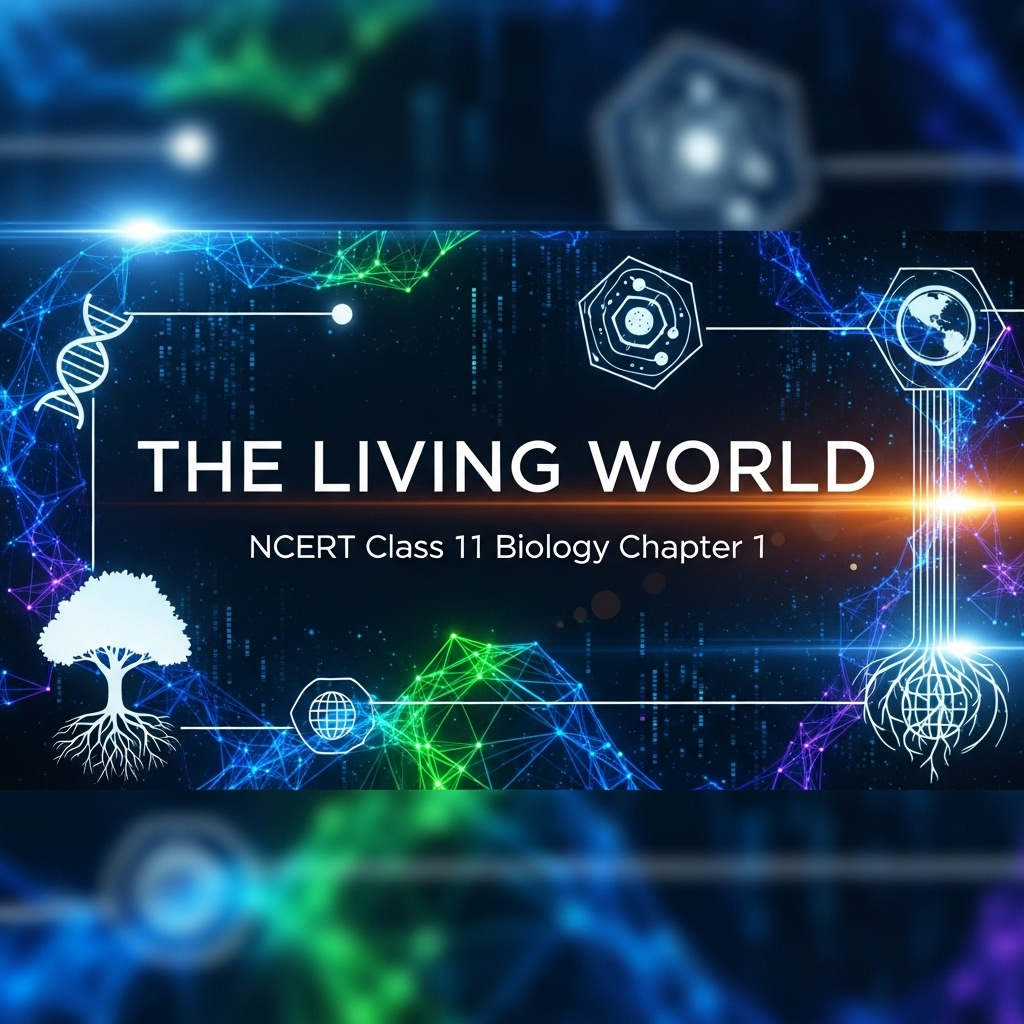Complete Solutions and Summary of The Living World – NCERT Class 11, Biology, Chapter 1 – Summary, Questions, Answers, Extra Questions
Comprehensive summary and explanation of Chapter 1 'The Living World', covering the characteristics of living organisms (growth, metabolism, cellular organization, consciousness), biodiversity, classification systems, taxonomic categories, and aids, binomial nomenclature, and the importance of taxonomy and systematic biology; includes all solved NCERT questions and extra practice material.
Updated: 2 months ago
Categories: NCERT, Class XI, Biology, Summary, Living Organisms, Biodiversity, Taxonomy, Classification, Chapter 1

The Living World
Chapter 1: Biology - Ultimate Study Guide | NCERT Class 11 Notes, Questions, Examples & Quiz 2025
Full Chapter Summary & Detailed Notes - The Living World Class 11 NCERT
Overview & Key Concepts
- Chapter Goal: Understand the diversity of life, characteristics of living organisms, taxonomy, and classification systems. Exam Focus: Biodiversity, nomenclature, taxonomic hierarchy. 2025 Updates: Emphasis on conservation and evolutionary relationships. Fun Fact: Ernst Mayr, 'Darwin of the 20th century,' pioneered species concepts. Core Idea: Living organisms share similarities and differences, leading to systematic classification. Real-World: Conservation movements, identifying species for agriculture and medicine.
- Wider Scope: Foundation for biology, links to ecology, evolution, and biotechnology.
Introduction: Diversity in the Living World
- The living world is amazingly diverse, with organisms in various habitats like mountains, forests, oceans, lakes, deserts, and hot springs. Examples include galloping horses, migrating birds, valley of flowers, attacking sharks.
- This diversity evokes awe and wonder. Ecological interactions, cooperation, and conflicts within populations and communities, as well as molecular processes inside cells, prompt reflection on 'what is life?'
- The question has two parts: technical (living vs. non-living) and philosophical (purpose of life). Scientists focus on the technical aspect.
- Variety includes potted plants, insects, birds, pets, and microscopic organisms. Increasing observation area increases diversity. Dense forests show greater numbers and kinds.
- Each kind represents a species. Known species: 1.7-1.8 million. This is biodiversity – number and types of organisms on Earth. New organisms are continuously identified.
Need for Nomenclature and Identification
- Local names vary by place, causing confusion. Standardization needed for global reference.
- Nomenclature: Process of naming organisms correctly. Identification: Describing organisms to attach names.
- Procedures established for scientific names, acceptable worldwide. Plants: International Code for Botanical Nomenclature (ICBN). Animals: International Code of Zoological Nomenclature (ICZN).
- Each organism has one unique name, ensuring no duplication.
Binomial Nomenclature
- Given by Carolus Linnaeus. Each name has two components: Generic name (genus) and specific epithet (species).
- Example: Mangifera indica (mango) – Mangifera is genus, indica is species.
- Rules: Latin/derived from Latin, italics/underlined, genus capital, species small letter. Author abbreviated at end, e.g., Mangifera indica Linn.
Classification and Taxonomy
- Classification: Grouping into categories based on observable characters. Examples: Plants, animals, dogs, cats.
- Terms like 'dogs,' 'mammals' associate characters. These are taxa – categories at different levels.
- Taxonomy: Process of classification based on external/internal structure, cell structure, development, ecology.
- Basic processes: Characterization, identification, classification, nomenclature.
- Early classifications based on uses (food, clothing, shelter). Later, interest in diversities and relationships led to systematics.
- Systematics: From Latin 'systema' – systematic arrangement. Includes identification, nomenclature, classification, evolutionary relationships.
- Linnaeus used Systema Naturae as book title.
Taxonomic Categories and Hierarchy
- Classification involves hierarchy of steps, each a taxonomic category or taxon (rank).
- All categories form taxonomic hierarchy.
- Example: Insects – three pairs of jointed legs, recognizable group (taxon).
- Common categories: Kingdom, phylum/division (plants), class, order, family, genus, species (lowest).
- Knowledge of characters helps identify similarities/dissimilarities.
1.2.1 Species
- Group of individuals with fundamental similarities, distinguishable from related species by morphological differences.
- Examples: Mangifera indica, Solanum tuberosum (potato), Panthera leo (lion). Specific epithets: indica, tuberosum, leo. Genera: Mangifera, Solanum, Panthera.
- Genus may have multiple species with similarities. Panthera tigris (tiger), Solanum nigrum, melongena.
- Humans: Homo sapiens.
1.2.2 Genus
- Group of related species with more common characters than other genera.
- Example: Solanum – potato, brinjal. Panthera – lion (leo), leopard (pardus), tiger (tigris). Differs from Felis (cats).
1.2.3 Family
- Group of related genera with fewer similarities. Characterized by vegetative/reproductive features (plants).
- Example: Solanaceae – Solanum, Petunia, Datura. Felidae – Panthera, Felis. Canidae – dogs.
- Cat and dog: Similarities and differences; different families (Felidae, Canidae).
1.2.4 Order
- Assemblage of families with few similar characters.
- Example: Polymoniales – Convolvulaceae, Solanaceae (floral characters). Carnivora – Felidae, Canidae.
1.2.5 Class
- Related orders. Example: Mammalia – Primata (monkey, gorilla, gibbon), Carnivora (tiger, cat, dog).
1.2.6 Phylum/Division
- Animals: Classes like fishes, amphibians, reptiles, birds, mammals – Chordata (notochord, dorsal neural system).
- Plants: Classes in Division (e.g., Angiospermae).
1.2.7 Kingdom
- Highest category. Animalia (animals), Plantae (plants).
- Hierarchy: Ascending – species to kingdom. Lower taxa more shared characteristics.
- Table 1.1: Examples for man, housefly, mango, wheat.
- Figure 1.1: Hierarchical arrangement.
Summary
- Living world rich in variety; millions identified, more unknown. Range in size, color, habitat, features.
- Taxonomy: Rules for identification, nomenclature, classification under codes.
- Useful in agriculture, forestry, industry, bio-resources.
- Binomial system: Two words, genus + species.
- Taxonomic hierarchy: Species to kingdom.
Why This Guide Stands Out
Complete chapter coverage: Notes, examples, Q&A (all NCERT + extras), quiz. Student-centric, exam-ready for 2025. Free & ad-free.
Key Themes & Tips
- Diversity: Amazing variety, biodiversity.
- Taxonomy: Identification, naming, classification.
- Hierarchy: Species to kingdom.
- Tip: Memorize hierarchy with examples; understand binomial rules.
Exam Case Studies
Questions on taxonomic categories, examples like mango, human.
Project & Group Ideas
- Collect local species, classify; discuss conservation.

Group Discussions
No forum posts available.


